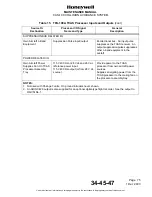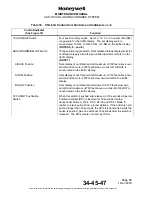
Page 87
1 Dec 2003
34-45-4
7
MAINTENANCE MANUAL
CAS-100 COLLISION AVOIDANCE SYSTEM
Use or disclosure of information on this page is subject to the restrictions in the proprietary notice of this document.
Table 18. CTA-81A Control Unit Controls and Indicators
(cont)
Control/Indicator
(See Figure 10)
Function
Function Selector Switch
(Cont.)
TA/RA Position (Cont.)
Mode C and Mode A interrogations. TCAS broadcasts and does
all Mode S and ATCRBS surveillance and tracking functions.
TCAS supplies traffic displays for RA, TA, proximity, and nonthreat
category aircraft
(see
NOTE 2.)
, transmits RA and TA alerts, and
transmits resolution advisories on the TA/VSI or RA/VSI. A TA/RA
annunciation comes into the view on the PPI or dedicated traffic
display. A mode annunciation is not given on the TA/VSI for TA/RA
mode.
(NOTE 3.)
On-the-Ground - Mode S transponder squitters and replies fully to
Mode S interrogations. Depending on transponder strapping,
transponder replies fully or does not reply to ATCRBS Mode C and
Mode A interrogations or Mode S interrogations. TCAS defaults to
TA ONLY mode (TCAS sensitivity level No. 2) and functions as
shown for the TA position (on-the-ground) of the Function Selector
Switch in this table.
FL Pushbutton Switch
Spring-loaded pushbutton switch. When pushed and released,
replaces relative altitude annunciations for the intruder aircraft on
the traffic display with own aircraft flight-level altitude
annunciations for a period of 15 seconds. During the 15 second
period, own aircraft flight-level altitude also shows on the traffic
display. After 15 seconds, own aircraft flight-level altitude goes out
of view from the display and intruder aircraft altitude annunciations
change to relative altitude annunciations.
(NOTE 4.)
If during the 15 second period after the FL switch is pushed and
released, a new RA or TA category aircraft is detected by TCAS,
the 15 second flight-level display is made unserviceable and
relative altitudes reappear.
















































